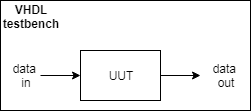Array, a collection of values of the same type, is very useful representation of data in VHDL. It is helpful during creating memory blocks (FIFOs, shift registers, RAM, ROM) or in designs where exist duplicated data flows, pipes or blocks (many ADC channels, filters etc). They can be used in synchronous designs as well as in combinational. But using it in combinational parts, sometimes for specific solution, it is very important to be aware how the code will be interpreted and synthesized.
To use the array object in the code, we need to do following steps:
- declare a new type
- declare signal of a new type
- use it properly in the code

